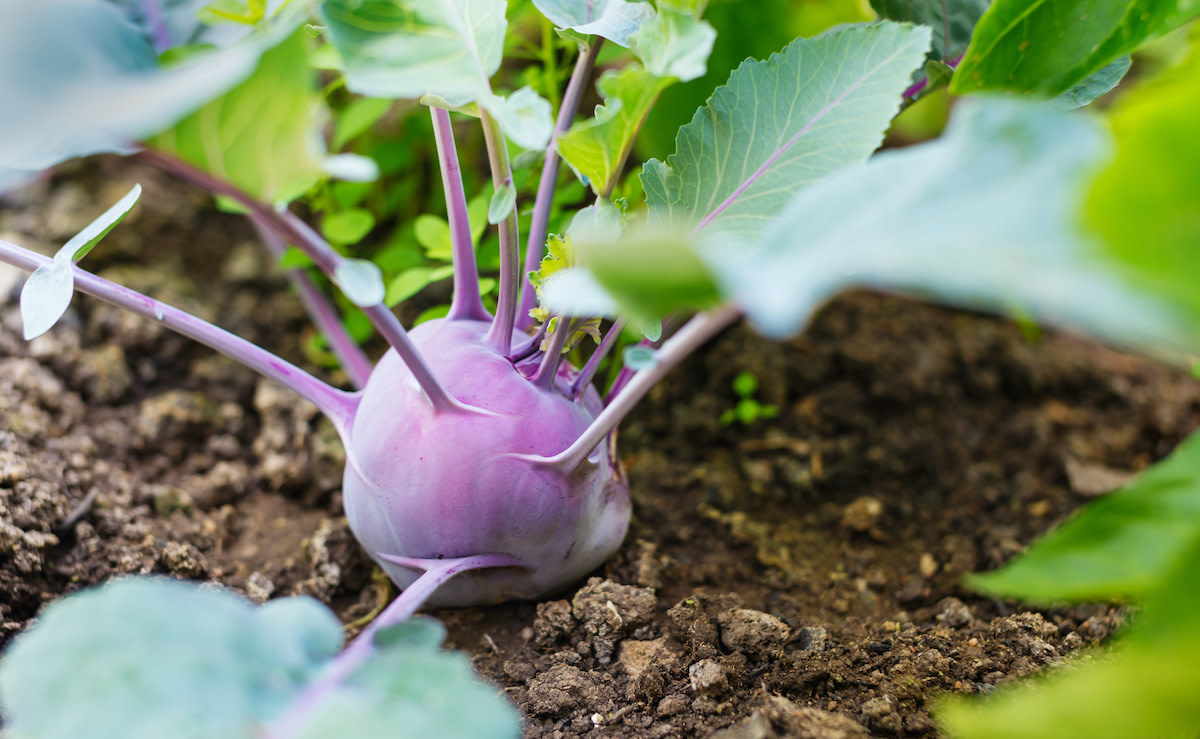How to Grow Kohlrabi in Your Backyard Garden
Written by MasterClass
Last updated: Jun 7, 2021 • 4 min read
Kohlrabi, also known as German turnip, is a biennial plant and member of the cabbage family. Not only is kohlrabi one of the hardiest vegetables you can grow in your garden, but it's a delicious option for anyone looking to add vitamin C, potassium, or fiber to their diet.
Learn From the Best
4 Types of Kohlrabi
There are numerous varieties of kohlrabi (Brassica oleracea) available in both hybrid and heirloom forms, each with varying characteristics such as flavor, color, size, growth rate, and disease resistance. Some of the most popular kohlrabi varieties include:
- 1. Early Purple Vienna: Maturing within 60 days, this heirloom purple variety is a cold-hardy crop with dependable yields. Its violet skin will add a vibrant color to your garden and its sweet, turnip-flavored flesh tastes delicious both raw and cooked.
- 2. Early White Vienna: Smaller than its purple counterpart and maturing within 55 days, this pale green kohlrabi is a cool-weather crop but is also heat tolerant. It has a more mild turnip flavor when cooked or raw.
- 3. Grand Duke: This disease-resistant pale green variety can produce two crops per season and thrives in many adverse weather environments. Grand Duke kohlrabi are crisp, full of flavor, and mature in only 45 to 50 days despite having one of the largest kohlrabi bulbs.
- 4. Kolibri: A bright purple hybrid variety, kolibri is one of the best types of kohlrabi for a late-season harvest that matures in 55 days. When eaten raw it has a crisp, juicy texture similar to an apple and a mild yet sweet cabbage flavor.
How to Plant Kohlrabi in Your Garden
Whether you choose to sow kohlrabi seeds outdoors or transplant seedlings that you start indoors, kohlrabi’s hardy nature makes it an easy-to-grow vegetable in a variety of climates.
- 1. Choose a planting time based on your climate zone. In cooler northern climates, produce a spring crop by sowing seeds outdoors right after the last frost (or start them indoors three to four weeks before the last frost, then transplant them outside). Those in cooler climates can also plant kohlrabi in midsummer for a fall harvest. In warmer southern climates, plant in the fall for a winter harvest. Note that kohlrabi plants thrive in temperatures between 40 and 75 degrees Fahrenheit and take between 45 to 60 days to mature, so plan accordingly depending on where you live.
- 2. Choose an area with enough sun. Plant kohlrabi in a full sun location with a minimum of six hours of sun per day. A partial shade location is acceptable if you're planting midsummer for a fall crop, as the shade will help cool down your seedlings during the warmer summer temperatures.
- 3. Make sure you have the right soil type. The ideal soil pH for kohlrabi is between 5.5 and 6.8, though slightly more alkaline soil helps prevent kohlrabi from developing clubroot disease. Kohlrabi plants flourish in fertile, well-drained loamy soil that is rich with organic matter.
- 4. Enrich your soil with nutrients. Before planting your kohlrabi, improve your soil by enriching it with aged compost or manure.
- 5. Know the proper planting depth and spacing. Sow kohlrabi seeds in rows a quarter of an inch deep and spaced nine to 12 inches apart. If transplanting seedlings from indoors, space seedlings five to eight inches apart. If planting multiple rows, arrange rows two feet apart.
How to Grow and Care for Kohlrabi
Once you've successfully planted your kohlrabi, follow the proper care regimen to maximize your crop yield.
- 1. Keep your soil moist. Kohlrabi plants should receive an even distribution of at least one and a half inches of water per week. Make sure not to overwater.
- 2. Add a layer of organic mulch. Once your plants have grown five inches tall, add a layer of organic mulch to the soil in order to suppress weed growth, lock in moisture, and cool the soil temperature.
- 3. Monitor for diseases. Kohlrabi is susceptible to clubroot disease, downy mildew, and powdery mildew. Clubroot causes wilting and yellowing of leaves and distorted roots; you can treat it by lime to your soil. Downy mildew and powdery mildew cause yellow patches and powdery white spots respectively, and both maladies can be treated using a proper fungicide.
- 4. Prevent pests. Cabbage worms and cabbage loopers are known to plague kohlrabi. You can control both pests with insecticides, but for a more natural approach, try companion planting—cabbage worms are deterred by thyme, nasturtiums, and onions while flowers like marigolds, daisies, and dill will attract beneficial insects that kill cabbage loopers.
How to Harvest Kohlrabi
Follow these harvesting guidelines to make sure you're cooking with the highest-quality kohlrabi possible.
- When to harvest: Kohlrabi plants are ready to harvest once their bulbs reach three inches in diameter.
- How to harvest: Cut the stem directly above the soil line at the base of the plant, separating the bulb from the root.
- How to store: Store kohlrabi in your refrigerator for up to three weeks.
Raw shredded kohlrabi is a wonderful addition to any salad, steamed kohlrabi tastes delicious in many soups, and you can even toss chopped kohlrabi into your favorite stir-fry.
Learn More
Grow your own food with Ron Finley, the self-described "Gangster Gardener." Get the MasterClass Annual Membership and learn how to cultivate fresh herbs and vegetables, keep your house plants alive, and use compost to make your community - and the world - a better place.
